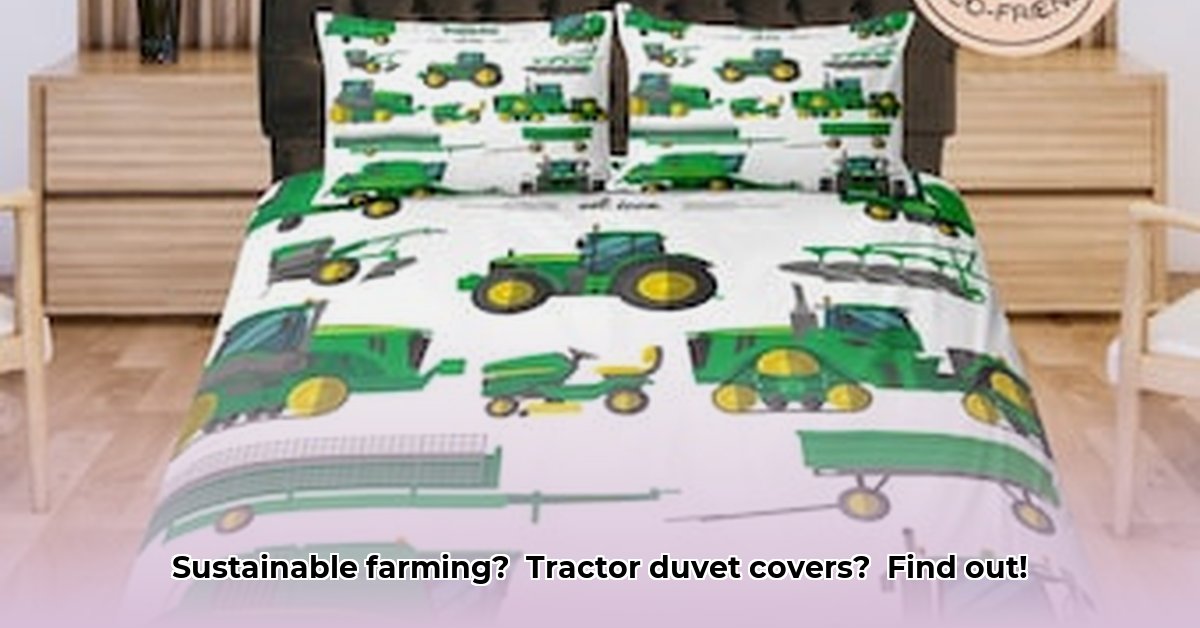
Tractor Duvet Covers: A Cozy, Green Revolution in Farming?
For years, the humble tractor duvet cover has remained largely unnoticed, a seemingly insignificant detail in the vast landscape of agricultural practices. Yet, the choices we make regarding even this seemingly minor aspect of farm equipment have a surprisingly significant impact on environmental sustainability. This article delves into the emerging market for eco-friendly tractor bedding, examining the factors contributing to a truly sustainable product, outlining actionable steps for manufacturers, farmers, and consumers, and ultimately, envisioning a greener future for farming, one comfortable tractor cover at a time. For more on farm equipment best practices, see the employee handbook.
Did you know that the typical tractor duvet cover's lifecycle contributes significantly to the overall environmental footprint of a farm? This includes the raw materials, manufacturing processes, and ultimate disposal of the product. This raises questions about sustainable alternatives and responsible production.
The Current State of Tractor Bedding: A Patchwork of Information
Finding a tractor duvet cover is simple; countless options are readily available online. However, securing reliable information regarding their environmental impact proves significantly more challenging. While certifications like OEKO-TEX STANDARD 100 (an independent testing and certification system that ensures textiles are free from harmful substances) offer a positive indication of reduced use of certain chemicals, this is only a part of the story. Crucial information regarding water usage, energy consumption during production, and the sourcing of raw materials often remains largely absent. This lack of transparency leaves farmers and conscientious consumers poorly equipped to make truly informed choices.
What Makes a Tractor Duvet Cover Truly "Sustainable"?
A truly sustainable tractor duvet cover operates on three interconnected pillars: sourcing of materials, responsible manufacturing practices, and end-of-life considerations.
Source Materials: The origin and nature of the raw materials are critical. Organic cotton, renowned for its reduced water and pesticide requirements compared to conventionally grown cotton, stands out as a prime example. Recycled materials offer an even greater advantage by repurposing existing resources. Transparency regarding the entire journey of the fiber, from field to fabric, is paramount.
Manufacturing Matters: The manufacturing process itself must prioritize sustainability. Minimizing water and energy usage, adopting renewable energy sources, and implementing closed-loop systems to minimize waste are crucial aspects. The absence of harmful chemicals throughout the manufacturing process is fundamentally important.
End-of-Life Considerations: The final stage of the product's lifecycle must also be carefully considered. Biodegradability and recyclability are essential for preventing landfill waste. A completely sustainable product is designed for a cyclical existence – ideal scenarios include complete compostability or seamless recyclability.
Working Together for a Greener Future: Actionable Steps for Everyone
The creation of a truly sustainable tractor duvet cover market requires collaborative efforts across various stakeholders.
1. Duvet Cover Manufacturers: Conduct comprehensive Life Cycle Assessments (LCAs) to fully understand their environmental footprint. Seek out broader certifications, such as the Global Organic Textile Standard (GOTS), in addition to OEKO-TEX. Strive for complete transparency across the supply chain, tracking and reporting environmental impact at each stage. Actively participate in the development of industry-wide sustainability standards.
2. Farmers: Demand complete transparency from suppliers. Prioritize duvet covers backed by robust certifications and detailed documentation from reputable third-party organizations. Minimize bedding waste, maximizing opportunities for recycling or composting. Advocate for policies and incentives that promote sustainable practices within the industry.
3. Policy Makers & Regulators: Develop clearer guidelines and regulations for sustainable agricultural textiles. Fund research into the development of truly eco-friendly alternative materials. Implement financial incentives for farmers and manufacturers who adopt sustainable practices.
4. Consumers: Choose certified products whenever possible. Support companies prioritizing transparency and sustainability. Use purchasing power to drive market demand towards eco-friendly practices.
How to Choose Sustainably Sourced Tractor Bedding
Choosing sustainable tractor bedding offers significant environmental benefits compared to conventional options. Conventional bedding often relies on harmful pesticides, synthetic dyes, and environmentally unsustainable practices. Sustainable options, however, offer both environmental and animal welfare advantages.
Prioritizing Materials: Defining Truly Sustainable Bedding
Sustainable bedding begins with the selection of materials. Organic cotton, linen, and hemp stand out as exceptional choices. Unlike conventional cotton, organic cotton avoids harmful pesticides. Linen and hemp are naturally durable and require less water for cultivation. Bamboo, a fast-growing renewable resource, needs careful assessment of processing methods to ensure its overall sustainability. Avoid synthetic materials like polyester, which has a significant environmental impact throughout its lifecycle.
Certification: Your Guide to Authentic Sustainability
Credible certifications provide essential verification of sustainability claims. Look for reputable certifications such as Global Organic Textile Standard (GOTS) 1 or OEKO-TEX Standard 100. These certifications involve rigorous testing and auditing, ensuring the absence of harmful chemicals and adherence to ethical production practices. A GOTS label guarantees organic farming practices and minimal environmental impact, while OEKO-TEX verifies the absence of harmful substances.
Supply Chain Transparency: Knowing the Origin of Your Bedding
A truly sustainable product demands a transparent supply chain. Thoroughly investigate the brands under consideration, seeking companies that openly share information about their processes, values, and social commitments. Transparency builds trust by ensuring ethical sourcing and minimal environmental harm.
Balancing Cost and Longevity: A Long-Term Perspective
Sustainable bedding may initially command a higher price than conventional alternatives. This reflects the fair compensation for organic agriculture and ethical labor practices. However, durable, high-quality materials often offer extended lifespans, reducing the need for frequent replacements. Sustainable bedding proves more cost-effective in the long run, while concurrently reducing landfill waste.
Choosing the Right Bedding for Your Needs
Choosing the perfect bedding depends on specific operational conditions including climate, intended bedding use, and animal needs. High-quality, sustainable bedding delivers comfort and healthy living conditions for livestock.